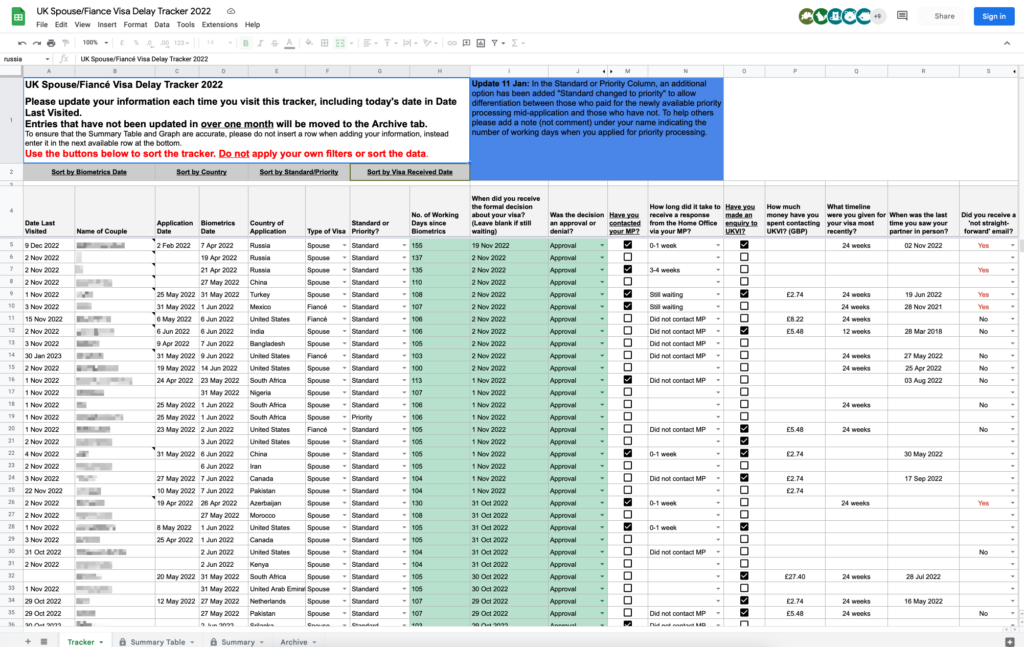This article is brought to you by Datawrapper, a data visualization tool for creating charts, maps, and tables. Learn more.
A tale of love, woe, and data vis
Hey everyone, this is Elliot, a data vis developer at Datawrapper. With it being Valentine’s Day next week, I wanted to share a love story about long-distance romance and crowdsourced data visualization.
Just over a year ago, my partner and I pulled the trigger on a long-brewing plan to move together from Brooklyn, USA to my home country of the United Kingdom. As an American, she would need a visa, which seemed simple in theory: we qualified for an “unmarried partner” visa, which typically took three months to process.
Having applied in April, we set about planning for a move in the summer. Little did we know that within a couple of weeks, the U.K. Home Office would email all applicants with some bad news. Due to an influx of Ukrainian refugees’ applications, the standard processing time had been extended to six months.
This update threw our plans, and the lives of many others, into disarray. We also weren’t sure how seriously to take the new timeframe. Was waiting six months a worst-case scenario, or a likely outcome?
In the absence of more detailed information from the authorities, the internet did what it does best: it crowdsourced. Within the Reddit community for “UK Visa Advice & News”, user “kokomade” had set up a large, openly-accessible spreadsheet where couples could share their own experiences in a tidy machine-readable format.

Within a few weeks, a pattern had emerged: applications were indeed taking up to six months to receive a decision.
And, in fact, we did end up waiting over six months for a decision — a rejection, based on a legitimate (if frustrating) technicality.
By this point, we had shipped our possessions to the U.K. (including our cat!), and I had moved to start a great new job at Datawrapper. My partner was crashing with friends and living out of a suitcase. The prospect of waiting the same time again was devastating.
Divination through data vis
Once we gathered the required evidence — more was needed to prove our relationship, now that we were living apart — we put in a new application and began what was expected to be another six-month wait.
I did try my best to resist checking the spreadsheet more than once a week. But by early December, I realized something different was happening this time. Wait times appeared to be dropping. Some people were getting decisions within 100 working days, which was unheard of almost a week ago. Was this a trend?
To find out, I imported the crowdsourced google sheet into Datawrapper and set up a scatter plot, with the decision date along the x-axis and wait time (in working days, so excluding weekends and holidays) along the y-axis.
The pattern hidden within the spreadsheet suddenly revealed itself: wait times were falling!
I didn’t want to jump to conclusions; but week by week, my chart slowly confirmed the trend. Despite not making any public statements, the Home Office was starting to make inroads into their backlog. And if the downward trend continued at the same pace, we were on track for a decision much sooner than expected.
By late December I felt confident enough to share the exciting news with my partner and post my chart on Reddit. Breaking the chart down a couple of ways revealed some interesting patterns.
In early 2022, the Home Office was still offering a priority service, which would see your application fast-tracked for an extra fee. But many of those appear to have been affected by the delays too, with wait times about the same as those who hadn’t paid more.
Some Reddit users were curious if the country they applied from made any difference to their wait time. U.K. applications are promised to be processed within eight weeks, and that is indeed borne out in the data. The only country experiencing longer delays is Russia, which… well, draw your own conclusions there.
Paying it forward
Just a few weeks later: a twist! The Home Office emailed some applicants — including us — with the news that they were re-opening priority service. For an additional £573, we could get a decision within days. With my partner’s accommodation only settled until the end of February, we chose to pay the fee and jump the queue.
After someone added a third status type to the spreadsheet, it was possible to see those applications’ wait times dropping well below the rest of the pack.
A couple of days later, we received the news we’d been waiting on for over a year: my partner’s visa had been granted! She finally arrived in the country last weekend. After months of stress and loneliness, it is a tremendous relief to know that we are finally reunited for good.
I’m thankful for the “ukvisa” Reddit community and the thousands of couples who shared their information in the spreadsheet. While it may not have sped up the process for any of us, it provided a window into an otherwise opaque process and gave us the hope we needed to see it through.
Meanwhile, the U.K. government’s website still lists the usual wait time for a decision as “within 24 weeks”. The crowdsourced data, however, suggests that normal service may be close to resuming. For the sake of lovers around the world, I sure hope that’s the case soon.
Thanks for reading! Wishing you all a happy Valentine’s Day, whether you’re spending it with or without a partner this year.




Comments